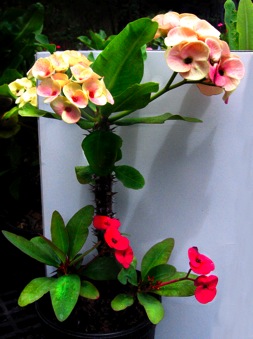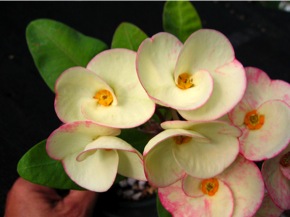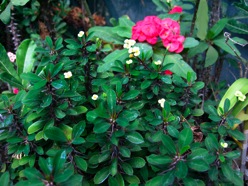
What are these plants? The poysean is a Euphorbia hybrid that has been developed in Thailand, where thousands of distinct varieties are said to have been made and cultivated over the last 30 years. They were initially exported to neighboring countries in the Far East, including Japan, India and the Philippines, where they are known simply as “Euphorbia”, the botanical name of the of their plant group. Their ease of cultivation and lush variety of perpetual blooms have inspired vast collections even here in Hawaii. Beautiful, large flowers blossom in abundant clusters throughout the year with very little human care.
Their forbears have actually been around since Victorian times, when explorers found E. milii and E. lophogona and their close relatives and brought them out of Madagascar and southern Africa.
The traditional Crown of Thorns have much smaller flowers and the plants may also be tiny. They may grow to be maintained as prickly hedges; but their flowers remain small and sometimes so small that they are not readily noticeable. The resilience and reliable blooming habit of the more colorful individuals have made them a favorite of plant lovers for a very long time. Many of us in the Cactus & Succulent Society of Hawaii continue to collect and dote on the diminutive classics --especially when they form caudexes.
Propagation of poysean is done mainly with cuttings, as the seedlings, for the most part, do not inherit the traits of the showy parents. They may take after their modest ancestors. A very small percentage will produce desirable flowers. Also, the number of viable seeds is extremely limited --3 seeds per “flower”.

Scions of many popular plants are grafted onto more common rootstock, which may be allowed to grow and bloom. The image above is of such a plant. The leaves and flowers of the rootstock are smaller than the Lucky Ruby that it supports. Together, they make a single plant that’s a ready made flower arrangement.


The cluster of “flowers” are not really flowers. Each flower is botanically called a “cyathium”. There is one pistillate (female)

flower surrounded by three tiny staminate (male) flowers. Each of the staminate flowers consists of a single stamen. Glands surround the flower. Around the flowers and glands are two big and colorful bracts, or “cyathophylls” that look like they should be petals. The well-developed bracts of Thai hybrids are much larger than those of earlier Crown of Thorns, and they come in an endless array of color combinations. Each flower cluster can last for several weeks, as more clusters are developing to bloom in their turn. Sun and temperature affect the colors of some varieties, and lovely changes are observed as the “flowers” develop.
How big do they grow? These are very well-behaved plants. Instead of sprawling in the manner of bougainvillas, untrimmed bushes do not get much past 5 feet tall. They also grow relatively slow and keep their branches to themselves. The longtime collectors that I’ve met are petite women who say they have plants that are taller than they are. These ladies sold several large plants for hundreds of $$$ each when the craze to obtain them spread like wildfire in 2005. The frenzy has passed since then. However, the search is still on for colors that one does not yet have.
Even now, not everyone has seen or heard of these generous bloomers. The purpose of this website is to promote familiarity with them. More points of interest will be added as this site develops.
(PC aside: In this age of horticultural responsibility, these may be considered environment-friendly plants. They are unlikely to escape into the wild to become rampant weeds that compete with native vegetation.)
Will the small potted plants grow branches? Most will eventually develop bushy growth. Only time will tell. I had a gangly plant for several years before it flushed forth several branches at it’s base. However, another single-stemmed plant grew only in height.

